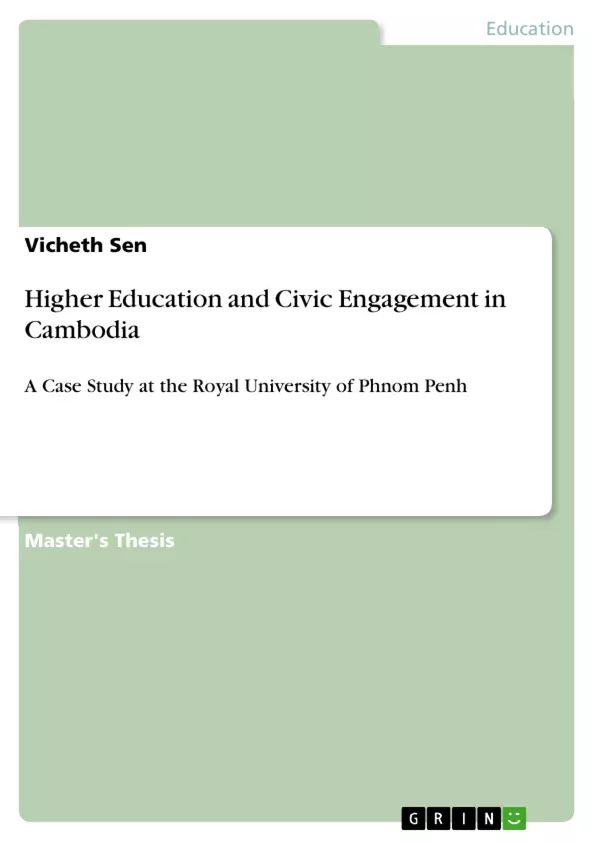In a democratic country, in particular a country in the process of being democratized, high levels of civic engagement from the public are seen as necessary factors to sustain the principles and livelihood of democracy. In the meantime, education, especially higher education, plays a very significant role in promoting citizenship and civic activism. This study tries to identify the levels of civic engagement among students at the Royal University of Phnom Penh and to investigate whether higher education has any significant part in fostering civic engagement among the students. To this end, 200 senior students at the Royal University of Phnom Penh, Cambodia’s oldest and largest public university, were surveyed. In the questionnaire, three main categories of civic engagement were used: (a) civic activities, (b) electoral activities and (c) activities for political voice. Results indicate that the students were engaged in only a few activities, but not many others. However, based on the results, the students showed high perceptions about civic activities and high attentiveness to politics and government. What is interesting, however, is that (higher) education and family—two fundamental social institutions—seem to have no significant roles to play in building civically engaged citizens. The findings appear to reflect the current socio-political developments in Cambodia. The study concludes that Cambodia’s historical context and current social, economic and political situations provide a strong basis for the results of the study.
Inhaltsverzeichnis (Table of Contents in English)
- ABSTRACT
- ACKNOWLEDGEMENTS
- TABLE
- LISTS OF TABLES AND FIGURES
- CHAPTER 1: INTRODUCTION
- 1.1 Background of the Study
- 1.2 Problem Statement
- 1.3 Research Questions
- 1.4 Significance of the Study
- 1.5 Limitations of the Study
- 1.6 Definition of Key Terms
- CHAPTER 2: LITERATURE REVIEW
- 2.1 Theoretical Framework
- 2.2 Literature on Civic Engagement
- 2.3 Literature on Higher Education and Civic Engagement
- 2.4 Literature on Civic Engagement in Cambodia
- CHAPTER 3: METHODOLOGY
- 3.1 Research Design
- 3.2 Population and Sampling
- 3.3 Data Collection Instrument
- 3.4 Data Analysis Procedures
- CHAPTER 4: RESULTS AND DISCUSSION
- 4.1 Demographic Characteristics of the Respondents
- 4.2 Students' Civic Activities
- 4.3 Electoral Activities of Students
- 4.4 Students' Political Voice Activities
- 4.5 Students' Perceptions of Civic Activities
- 4.6 Students' Attentiveness to Politics and Government
- 4.7 Students' Participation in Groups and Organizations
- 4.8 Factors Influencing Students' Civic Engagement
- 4.9 Discussion
- CHAPTER 5: CONCLUSION
- 5.1 Summary of Findings
- 5.2 Implications of the Study
- 5.3 Recommendations
- REFERENCES
Zielsetzung und Themenschwerpunkte (Objectives and Key Themes in English)
This study aims to examine the levels of civic engagement among students at the Royal University of Phnom Penh and investigate the role of higher education in fostering civic engagement. The research investigates the extent to which students participate in civic activities, electoral activities, and activities related to expressing their political voice.- The study explores the levels of civic engagement among students at the Royal University of Phnom Penh.
- The research investigates the role of higher education in promoting civic engagement among students.
- The study examines the influence of family, education, and socio-political factors on civic engagement.
- The research aims to understand the perspectives of students on civic activities, politics, and government.
- The study analyzes the relationship between students' participation in groups and organizations and their civic engagement.
Zusammenfassung der Kapitel (Chapter Summaries in English)
The first chapter introduces the background, problem statement, research questions, significance, limitations, and key terms of the study. Chapter two presents a comprehensive literature review, discussing the theoretical framework, existing research on civic engagement, higher education and civic engagement, and civic engagement in Cambodia. Chapter three outlines the methodology of the study, including the research design, population and sampling techniques, data collection instrument, and data analysis procedures. Chapter four focuses on the results and discussion of the study. This section provides a detailed analysis of the demographic characteristics of the respondents, their civic activities, electoral activities, political voice activities, perceptions of civic activities, attentiveness to politics and government, participation in groups and organizations, and the factors that influence their civic engagement.Schlüsselwörter (Keywords in English)
The primary keywords and focus topics of this study include civic engagement, higher education, Cambodia, Royal University of Phnom Penh, students, political participation, social institutions, and socio-political context. The research explores the relationship between higher education and civic engagement in the specific context of Cambodia, examining the factors that influence student participation in civic life.- Citar trabajo
- Vicheth Sen (Autor), 2008, Higher Education and Civic Engagement in Cambodia, Múnich, GRIN Verlag, https://www.grin.com/document/149269



